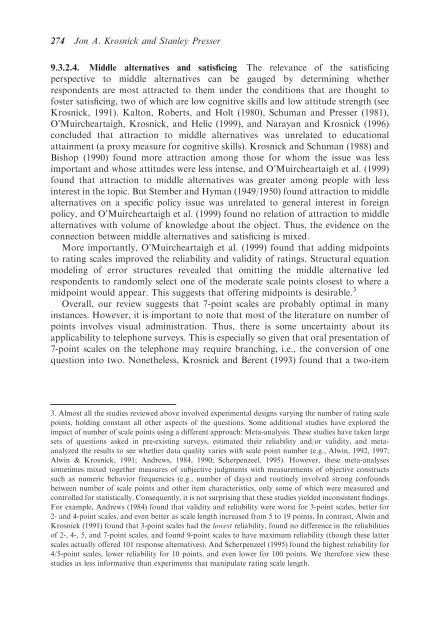Question and Questionnaire Design - Stanford University
Question and Questionnaire Design - Stanford University
Question and Questionnaire Design - Stanford University
You also want an ePaper? Increase the reach of your titles
YUMPU automatically turns print PDFs into web optimized ePapers that Google loves.
274 Jon A. Krosnick <strong>and</strong> Stanley Presser9.3.2.4. Middle alternatives <strong>and</strong> satisficing The relevance of the satisficingperspective to middle alternatives can be gauged by determining whetherrespondents are most attracted to them under the conditions that are thought tofoster satisficing, two of which are low cognitive skills <strong>and</strong> low attitude strength (seeKrosnick, 1991). Kalton, Roberts, <strong>and</strong> Holt (1980), Schuman <strong>and</strong> Presser (1981),O’Muircheartaigh, Krosnick, <strong>and</strong> Helic (1999), <strong>and</strong> Narayan <strong>and</strong> Krosnick (1996)concluded that attraction to middle alternatives was unrelated to educationalattainment (a proxy measure for cognitive skills). Krosnick <strong>and</strong> Schuman (1988) <strong>and</strong>Bishop (1990) found more attraction among those for whom the issue was lessimportant <strong>and</strong> whose attitudes were less intense, <strong>and</strong> O’Muircheartaigh et al. (1999)found that attraction to middle alternatives was greater among people with lessinterest in the topic. But Stember <strong>and</strong> Hyman (1949/1950) found attraction to middlealternatives on a specific policy issue was unrelated to general interest in foreignpolicy, <strong>and</strong> O’Muircheartaigh et al. (1999) found no relation of attraction to middlealternatives with volume of knowledge about the object. Thus, the evidence on theconnection between middle alternatives <strong>and</strong> satisficing is mixed.More importantly, O’Muircheartaigh et al. (1999) found that adding midpointsto rating scales improved the reliability <strong>and</strong> validity of ratings. Structural equationmodeling of error structures revealed that omitting the middle alternative ledrespondents to r<strong>and</strong>omly select one of the moderate scale points closest to where amidpoint would appear. This suggests that offering midpoints is desirable. 3Overall, our review suggests that 7-point scales are probably optimal in manyinstances. However, it is important to note that most of the literature on number ofpoints involves visual administration. Thus, there is some uncertainty about itsapplicability to telephone surveys. This is especially so given that oral presentation of7-point scales on the telephone may require branching, i.e., the conversion of onequestion into two. Nonetheless, Krosnick <strong>and</strong> Berent (1993) found that a two-item3. Almost all the studies reviewed above involved experimental designs varying the number of rating scalepoints, holding constant all other aspects of the questions. Some additional studies have explored theimpact of number of scale points using a different approach: Meta-analysis. These studies have taken largesets of questions asked in pre-existing surveys, estimated their reliability <strong>and</strong>/or validity, <strong>and</strong> metaanalyzedthe results to see whether data quality varies with scale point number (e.g., Alwin, 1992, 1997;Alwin & Krosnick, 1991; Andrews, 1984, 1990; Scherpenzeel, 1995). However, these meta-analysessometimes mixed together measures of subjective judgments with measurements of objective constructssuch as numeric behavior frequencies (e.g., number of days) <strong>and</strong> routinely involved strong confoundsbetween number of scale points <strong>and</strong> other item characteristics, only some of which were measured <strong>and</strong>controlled for statistically. Consequently, it is not surprising that these studies yielded inconsistent findings.For example, Andrews (1984) found that validity <strong>and</strong> reliability were worst for 3-point scales, better for2- <strong>and</strong> 4-point scales, <strong>and</strong> even better as scale length increased from 5 to 19 points. In contrast, Alwin <strong>and</strong>Krosnick (1991) found that 3-point scales had the lowest reliability, found no difference in the reliabilitiesof 2-, 4-, 5, <strong>and</strong> 7-point scales, <strong>and</strong> found 9-point scales to have maximum reliability (though these latterscales actually offered 101 response alternatives). And Scherpenzeel (1995) found the highest reliability for4/5-point scales, lower reliability for 10 points, <strong>and</strong> even lower for 100 points. We therefore view thesestudies as less informative than experiments that manipulate rating scale length.
















